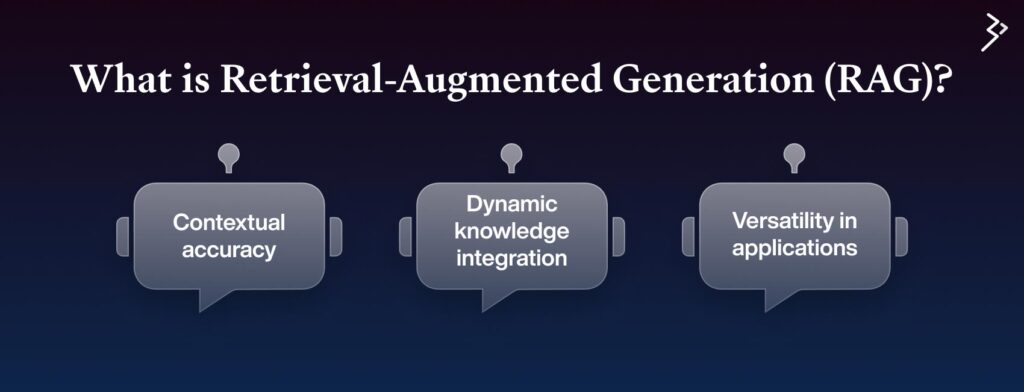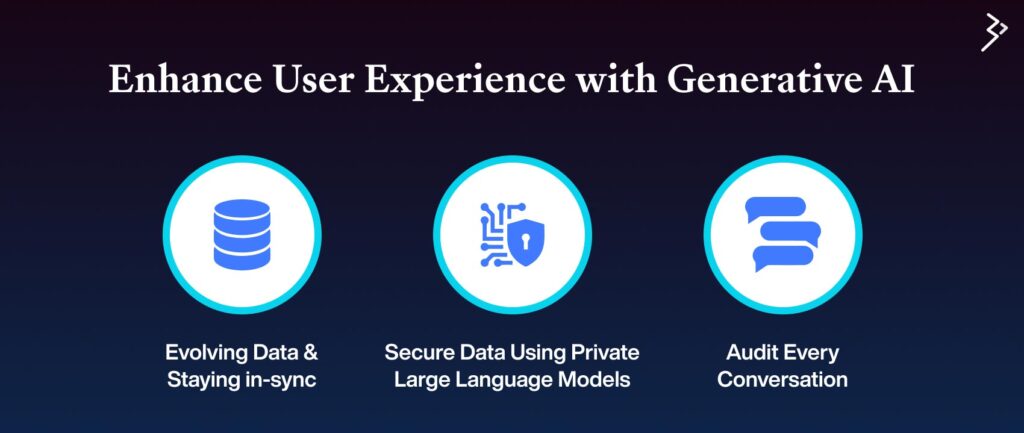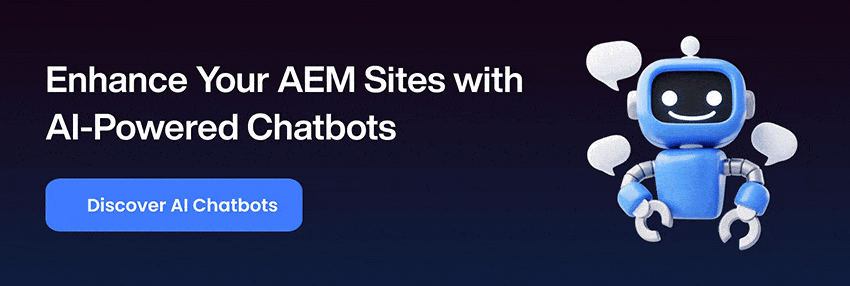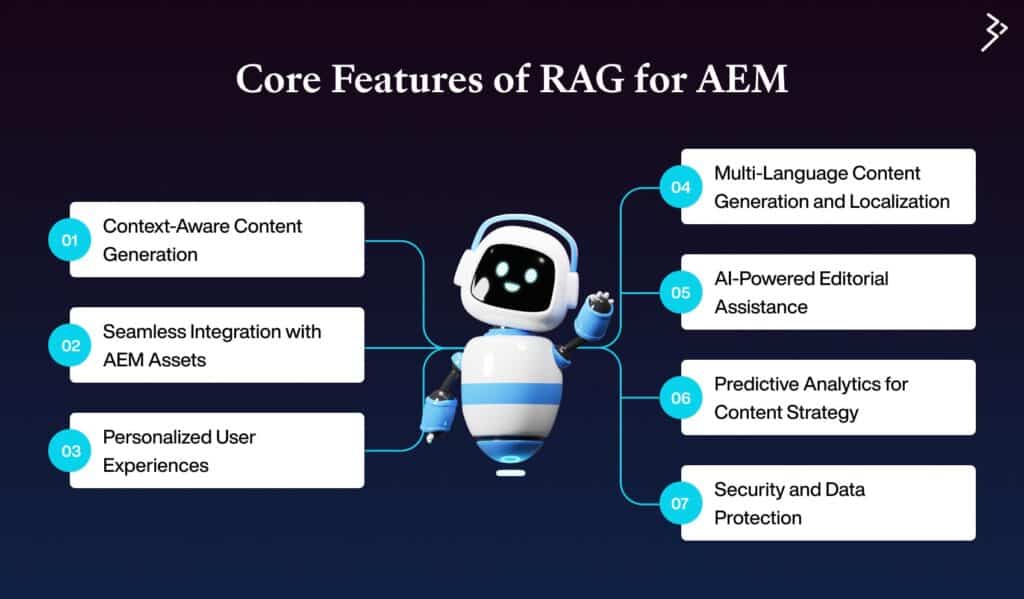In today’s digital world, customers have more expectations than ever before. They want rapid and easy access to information for sales, customer service, or knowledge management.
Adobe Experience Manager Services (AEM) sites may now use Generative AI-powered chatbots to achieve these goals. These chatbots provide a game-changing solution for better user experiences, faster data retrieval, and actionable insights.
In this article, we’ll examine how to use retrieval-augmented generation (RAG) chatbots on your Experience Manager Sites website to harness the power of generative AI.
The Future of AI Inputs
Content silos impede our access to information and insights. Most businesses struggle to retrieve content from several silos and manually synthesize it for information. Customers anticipate that generative AI will provide faster and more efficient access to information as solutions such as ChatGPT gain popularity.
SearchBlox SearchAI, a platform for RAG chatbots, fundamentally improves how consumers discover information with generative AI. SearchAI ChatBot is your copilot or assistant, helping you find information quickly, effectively, and in new ways.
What is Retrieval-Augmented Generation (RAG)?

At its essence, RAG pushes search queries beyond typical limitations. Unlike traditional search engines, which depend exclusively on keywords, RAG uses semantic search and generative AI to communicate with your data. This method allows SearchAI to locate the most relevant information while generating insights and exact responses not directly present in the data. RAG may also synthesize responses from several content silos, saving consumers a lot of time.
Why is RAG a game changer?
- Contextual accuracy: RAG recognizes the intricacies and context of semantic questions, resulting in more accurate and relevant responses.
- Dynamic knowledge integration: RAG constantly integrates fresh information, ensuring the responses are always based on current facts.
- Versatility in applications: From academic research to market analytics, RAG’s versatility makes it a valuable approach for embedding this solution into your application across several sectors.
Read More-: How to Use Generative AI to Its Full Potential in Your Adobe Commerce Store
Enhance User Experience with Generative AI

The incorporation of RAG improves the user experience. Users are no longer frustrated by having to sort through irrelevant results. Instead, customers receive accurate, complete answers and insights. This efficiency is more than just time-saving. It’s a game changer for professionals who require timely and precise information.
Consider a financial analyst examining financial papers, a researcher investigating complex research findings, or a marketer assessing consumer feedback. With RAG-powered chatbots, these experts can access papers and find the exact response or answer without having to open or go through pages inside the documents, accelerating their job to new levels of efficiency and precision.
Evolving Data & Staying in-sync
Your data is continuously evolving, and so should your generative AI and chatbot platform. Your users want the most recent information, and your platforms must keep up with changing data to prevent presenting incorrect or outdated information.
Experience Manager Sites creators may publish data and make material and documents available immediately. Your chatbot should be regularly updated, allowing for document additions, revisions, and deletions. SearchAI can get data and documents from over 300 sources and handle any database, file format, or document structure.

Secure Data Using Private Large Language Models (LLMs)
Most firms prioritize security while planning their AI journey and selecting the best platform for their use cases. Using a private LLM reduces security worries over RAG and chat exchanges where users may enter queries or submit information. A private LLM can also assist you manage at a set cost. SearchAI uses a private LLM to keep your data within your firewalls or borders.
Audit Every Conversation
Every communication should be recorded and reviewed for compliance and correctness. Using SearchAI, administrators may easily examine and update chats and save them for reporting. Conversations enable us to control trends and be proactive about client happiness.
Read More-: How Combination of BigCommerce and AI Helps E-commerce
Core Features of RAG for AEM

1. Context-Aware Content Generation
RAG’s ability to produce contextually relevant information is a significant AEM feature. Unlike classic generative models, which depend primarily on pre-trained knowledge, RAG dynamically collects appropriate information from AEM repositories and external data sources. This guarantees that created information is up to date, brand-compliant, and relevant to particular business requirements. For example, a company’s product descriptions or marketing material may be automatically adjusted using the most recent data without human participation.
2. Seamless Integration with AEM Assets
AEM offers a robust digital asset management (DAM) system, which RAG effortlessly connects with. To improve content development, the model extracts relevant materials, such as templates, photos, and papers. This feature eliminates the need for content producers to actively search for assets because the AI will automatically propose the finest media to complement the created text. The integration increases productivity while maintaining a consistent brand identity across several platforms.
3. Automated Content Summarization and Tagging
With the growing volume of digital material, effective administration necessitates automation. RAG contributes by condensing significant papers, articles, or reports into brief, useful content bits. It also automates metadata tagging by extracting crucial information from documents and applying relevant SEO-friendly tags, keywords, and categories. This functionality increases searchability and content discoverability inside AEM.
4. Personalized User Experiences
Personalization is an essential part of current digital encounters. RAG provides hyper-personalization by creating content based on users’ choices, browsing history, and interaction habits. AEM-powered websites and applications can offer dynamic, audience-specific content that increases user engagement and conversion rates by obtaining user-specific data and combining it into produced text.
5. Multi-Language Content Generation and Localization
Global firms must provide content in several languages to reach a wide range of people. RAG in AEM enables multilingual content production by extracting language-specific data and producing high-quality translations. It also adjusts information to cultural subtleties, ensuring localization efforts go beyond simple translation. This function drastically minimizes manual work in content translation while ensuring uniformity and correctness.
6. Enhanced Search and Knowledge Retrieval
AEM users frequently want rapid access to relevant material, documents, and insights. RAG enhances search capabilities by obtaining relevant information from structured and unstructured data sources inside AEM. It improves enterprise search by offering direct responses, summarizing key documents, and recommending similar material based on user queries. This functionality is especially valuable for large enterprises that manage enormous digital content collections.
7. Content Governance and Compliance
Businesses find it challenging to maintain compliance with brand guidelines, industry rules, and regulatory obligations. RAG supports content governance by collecting and aligning created material against preset compliance guidelines. It detects anomalies, flags possible compliance concerns, and enforces regulatory requirements in real time, lowering the likelihood of non-compliant information being published.
8. AI-Powered Editorial Assistance
Content teams in AEM may use RAG to provide intelligent editing help. The approach helps authors by recommending relevant information, enhancing readability, and guaranteeing consistency in tone and style. It also offers real-time grammar and style guidelines, making it a valuable tool for content marketers and editors who want to maintain high-quality production.
9. Efficient Content Repurposing
RAG allows for the reuse of current material in various formats and platforms. Whether converting a blog article into a social media snippet, an email newsletter, or an infographic, the model extracts and rephrases material to fit various distribution channels. This provides a consistent message across platforms and saves time on laborious content adaptation.
10. Adaptive Learning and Continuous Improvement
In AEM, RAG stands out for its capacity to learn and adapt over time. The model’s retrieval and creation processes are constantly refined depending on user interactions, feedback, and performance indicators. This constant refinement ensures that material remains current, engaging, and aligned with evolving market trends.
11. Integration with Third-Party Data Sources
RAG in AEM is designed to extract data from internal repositories and external databases, APIs, and third-party content sources. This option improves content correctness and relevance by replenishing the AEM library with new, high-quality data. RAG guarantees that material is updated with the most recent findings by connecting with market research platforms, financial databases, and consumer feedback systems.
12. Scalability for Enterprise-Level Content Operations
Enterprises with high-volume content operations demand scalable solutions. RAG guarantees AEM can handle large-scale content development while maintaining speed and quality. The system can process and produce thousands of pieces of content simultaneously, making it an excellent alternative for large enterprises needing automation without losing customization or accuracy.
13. Predictive Analytics for Content Strategy
RAG predicts content performance using machine learning services and retrieval algorithms. It evaluates user engagement metrics, trends, and content efficacy to make data-driven content recommendations. Marketers may utilize these analytics to improve campaign performance, SEO rankings, and audience engagement.
14. Real-Time Collaboration and Workflow Optimization
RAG can help AEM teams collaborate more effectively by offering real-time content ideas, workflow automation, and approval processes. AI-driven suggestions ensure that several teams working on a project have access to the most relevant material, reducing redundancy and increasing efficiency. Automated process triggers also assist in expediting content approvals and publication schedules.
15. Security and Data Protection
Data security is a significant responsibility for businesses that handle sensitive client information. RAG in AEM includes strong security mechanisms to secure retrieved data through encryption, access restrictions, and compliance with data protection requirements like GDPR and CCPA. AI-powered risk assessment solutions detect and mitigate possible security issues, guaranteeing secure content management methods.
Deploying RAG for Adobe Experience Manager
Integrating RAG into SearchAI is more than a step forward; it is a leap into the future of generative AI development services. As we go forward in an era where data is the new oil and content is king, an organization’s ability to harness this data quickly and accurately is critical to its success. Whether you store documents or data, RAG will affect how your users may access and use it. Native integration allows SearchAI to retrieve the material and update the chatbot immediately.
SearchAI’s built-in RAG is a key step in deploying generative AI capabilities. This potent combination is poised to change the norms of information retrieval and creation, providing unrivaled precision and efficiency.
Chatbots may power your discussions utilizing RAG with little to no effort to tag, categorize, or process them for further extraction, independent of document type or data format. SearchAI allows you to create one or more chatbots easily and embed them into your Experience Manager website. A chatbot can be utilized across several sites to provide external data such as consumer product suggestions or customer assistance.
What is the Engagement Level of a RAG-based Chatbot?
Capturing the appropriate KPIs to demonstrate the commercial benefit of your chatbot is critical for leadership. Every chat session engages your consumers or staff and should be recorded and studied for development. If we notice recurring problems with certain questions or replies, using feedback from upvotes or downvotes might help us understand how to improve the conversations.
Deploying RAG-based chatbots on your Experience Manager Sites website gives you a significant edge in delivering better user experiences, getting correct information, and offering valuable insights. By embracing the potential of generative AI, you can redefine how your company interacts with data and consumers.
Incorporating RAG and generative AI into Experience Manager Sites will help you stay ahead of the curve and uncover a future in which information is intelligently gathered and distributed.
Related Articles
-
What is the Navigation in Adobe Experience Manager (AEM)?
Summary Delivering a seamless user experience is crucial for evolving businesses! Today, more than ever, customers are inclined towards the look and feel of a website before trusting the brand.
-
Leveraging Adobe Substance 3D For High-Impact Marketing
The ability to create captivating, lifelike imagery can set a brand apart. With stunning, hyper-realistic 3D designs, businesses can engage audiences, streamline workflows, and push the boundaries of creativity. In
-
Why Enterprises are Moving to Adobe Commerce Cloud for Scalable eCommerce?
Summary Choosing the right platform can be the most crucial aspect of your business! Wonder why? There are nearly 26 million eCommerce websites on the Internet, indicating that your business




